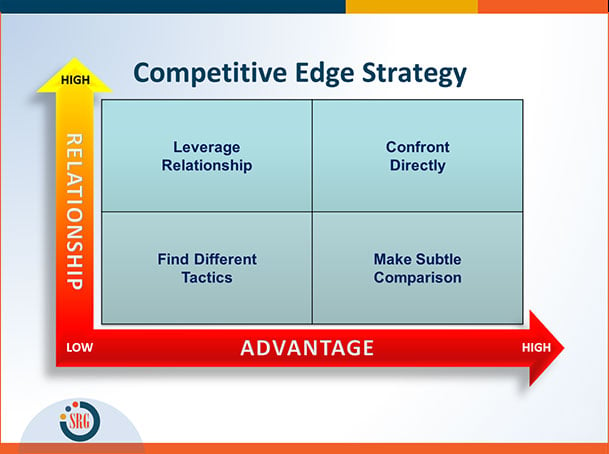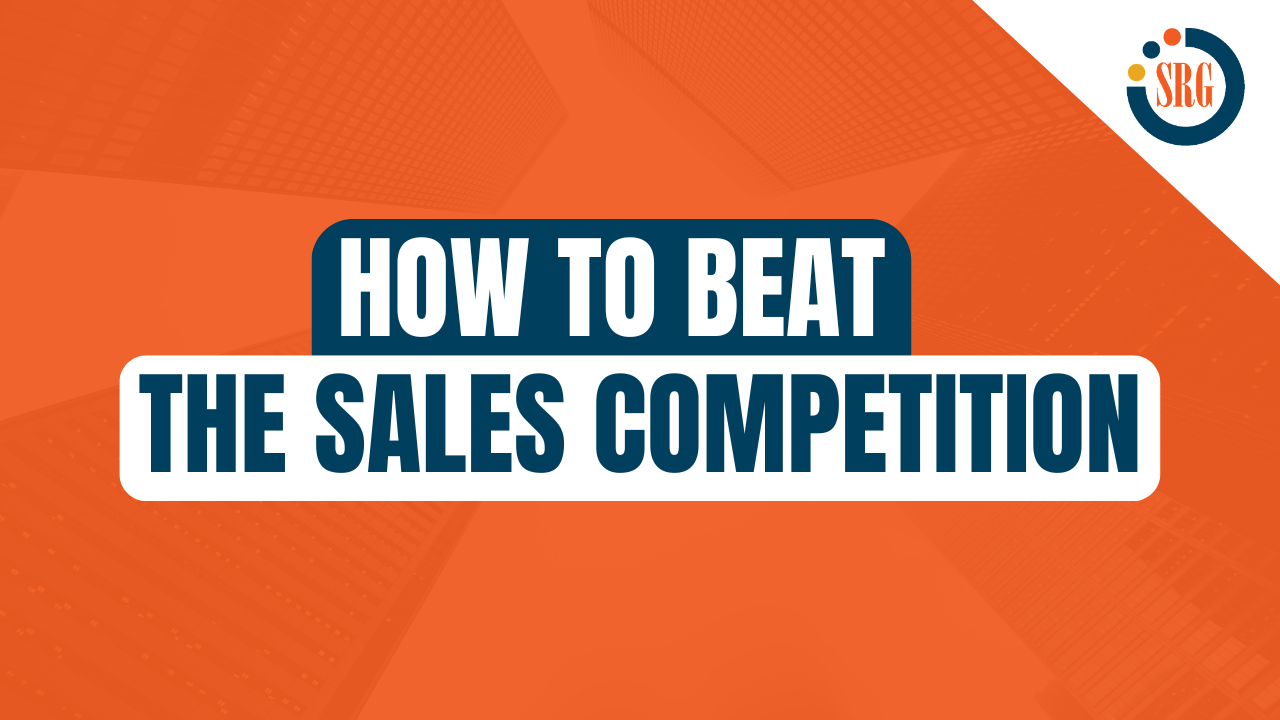There is no escape from competition in sales. Whether it is already apparent or lurking around the corner, the challenge remains the same—to outperform and win deals. Let’s look at what sales reps can do to achieve a competitive edge through analysis, strategic planning, and skillful presentation.
Table of Contents
How to Develop a Competitive B2B Sales Strategy
Direct competition significantly increases the complexity of the sales process. It forces you to understand what the buyer wants, how your solution addresses their needs, and how it stacks up relative to the market.
The key is to have a process to analyze the competition, identify a strategy for your competitive presentation, and select the appropriate method when prospecting.
1. Analyze the Competition
The first step in achieving a competitive edge is identifying your competition and knowing their strengths and weaknesses. It requires ongoing research, awareness, and questioning. To make a competitive comparison, you will need to:
- Consider everything you offer - product features, company strengths, support services, value-added benefits, etc.
- Rank each aspect of your offering (e.g., definite disadvantage, slight disadvantage, seems equal, slight advantage, definite advantage) relative to the competition.
- Identify your relative strengths and weaknesses.
During the analysis, consider all of the benefits your product or solution provides the customer, including benefits beyond those directly provided by the product or service itself. It can include special services, company experience and reputation, training, consulting, engineering, promotions, financing options, and more.
2. Identify a Strategy
After you have conducted a competitive analysis, you need a strategy for your sales presentation. It must be determined by assessing your relationship with the buyer and how your competitive analysis positioned your overall advantage relative to the competition.

Confront Directly
The ideal position is when you have a “high” relationship with the buyer and a “high” advantage. In this case, it makes sense to confront the competition directly and present the buyer with a detailed analysis of how you compare to the competition, including relating your strengths to the buyer’s needs.
Make a Subtle Comparison
A less desirable position on the matrix is the lower right-hand quadrant - a "high" advantage but a "low" relationship, or one that has not been fully developed—which requires a more subtle comparison.
In this case, avoid mentioning the competitor by name since the buyer may have a strong relationship with them. Instead, try achieving some balance in your presentation to build your credibility by occasionally admitting a minor advantage of your competitor.
Leverage a Relationship
A much more challenging situation is when your relationship is "high," but your advantage is "low." In this case, it is essential to leverage your relationship to the extent possible and focus on the few areas where you have some advantage.
Find Different Tactics
Finally, the lower left-hand quadrant is the most challenging because you have neither a strong relationship nor a competitive advantage. Here, you will need to be creative and try to identify one slight advantage you have and emphasize its importance with data or testimonials.
Another tactic is to admit a disadvantage and turn it into an advantage (“Yes, we are a small firm, but that means your account will be managed directly by a partner”). You can also bring in your company’s senior leadership team members to reinforce interest, dedication, and importance.
3. Present Your Offer
The presentation method you choose should be determined by your relationship with the decision-maker and the extent of your advantage. Here are four common methods:
Method #1: Priority
This method works well when you have identified the decision maker’s priorities: product/service needs and business concerns. It will make a powerful presentation if you match your strengths with these priorities.
For example, if the decision-makers primary concern is service and your competitive analysis gives you high marks in this area, build your presentation and competitive comparison around this priority.
Method #2: Top 3
Another approach is to focus on the three features you identified in your competitive analysis where you have the greatest advantage.
Three is not a magic number (it could be two or four), but limiting your presentation to three key features and related benefits allows you to be more focused and get better results. This technique works best with significant advantages in limited areas.
Method #3: Vulnerable Feature
If the competition comes up in one area where they are particularly vulnerable, it can be a logical point of attack. You have to be subtle in using this method, couching your comparison in phrases like:
I know you are also considering XYZ's new product, and while both products provide similar benefits, I would like to show you why ours can provide a better return. Let's compare the two in terms of the total cost of ownership over five years..."
If you use this method, try to select a vulnerable feature essential to the decision-maker rather than building your story around a relatively minor or insignificant one.
Method #4: Total Comparison
The total comparison method works best when your analysis provides a broad range of advantages and weaknesses compared to a specific competitor. While you usually won't compare every feature with the decision-maker due to time limitations and lack of focus, you should select several features (about 6 to 10) to compare.
From a tactical viewpoint, it is a good idea to include some features where you have a slight disadvantage to give your presentation the appearance of "fair balance." While you can't control the competition, you can carefully shape your sales presentations to maximize your competitive strengths and minimize your weaknesses.
Developing Your Messaging
Though you may (and should) have convinced yourself that you are the best option for the customer, you may not have communicated that message enough to your customer in terms that differentiate you from the competition.
Play to your strengths, highlighting those areas where you know you have a better solution fit than the competitor. Put them in terms of priorities the customer shared with you. In other words, what do these differentiators mean to the customer?
You also need to develop messaging around your known weaknesses or shortcomings. Decide whether to preempt these questions or objections by bringing them up in advance (if they will likely come up anyway) or at least be prepared to respond when the issue arises.
You may also have to respond to misconceptions or false information planted by the competitor. The key here is to listen to the customer and clarify the concern or objection. Then, respond in a way that highlights your strengths and why you are the best fit for the customer.
How to Sell Against a Competitor When You Think They Are Better
If, even after comparing your solution to the competition and developing your messaging, you still find yourself in a position where you are wondering about your chances relative to other products/solutions available on the market, you should ask yourself: “Why do you think the competitor's product is better than yours?” Did the competitor tell you that their product is better than yours? Or did your client tell you that?
As a salesperson, you need to work hard to determine why you are the best fit for your client, how you add unique value, and why you are the best solution. If you can't figure these out, convincing clients that you are the best fit won't be easy. Still, there are a couple of things you can do to get closer to closing the deal.
1. Understand Their Unique Needs
Ask questions early in the discovery process to uncover the extent of their problem. Help them understand their problems in ways that they haven't even considered, ask about how much pain their problem is causing, and what the future would look like if they addressed that situation.
2. Determine How You Will Fulfill Them
Resist the urge to be commoditized and be put in a situation where every product looks the same. Understand their needs early in the conversation and determine ways that you can fulfill them better than the competition.
3. Quantify Your Unique Value
Once you have uncovered their needs and the value you can provide, break it into components you can quantify. Now, you can help them build a business case to justify their solution and support choosing you to deliver it.
4. Differentiate Yourself by Selling Actions
A prospect knows that going through the sales process is one example of what it will be like to work with you and your company. Because of that, they often decide to work with you because of how you interact and how they feel about you. So, the better you develop rapport and build that relationship during this process, the better you will gain that business.
How to Deal with Competitors Who Lie
Chances are, your competitors might look better on paper because what they are saying is misleading or flat-out incorrect. And it isn't easy to sell against because the customer doesn't necessarily know the difference.
Next time you encounter this, consider the following five steps.
1. Never Bad-Mouth the Competition
It doesn't help your situation, and by saying that they are misleading or lying, you may look like you are trying to cast doubt on or disparage them.
Instead, start with a quick competitive analysis. Look at the strengths and weaknesses compared to the competitor you are hearing about and compare them to your offerings to understand where you are strong and where you may have weaknesses to overcome.
2. Play to Your Strengths
Next, highlight the areas where you are differentiated and get ahead of any areas where you may have a weaker solution. You want to reframe the conversation if you know there is an area that you need to tread lightly, or maybe the competition is stronger.
For example, if you hear that your solution is much more expensive than the competition, try to reframe that conversation around the total cost of ownership. Maybe your solution is a little bit more expensive today, but over three to five years, when you factor in training, support, warranty, and all the other factors that come into play, it may become a much better option than a lower up-front cost.
3. Address Issues with Proof
The third step is to pre-emptively address any issues you think may come up or that maybe they have misled the customer about by providing proof.
If you know that there is a misleading fact or statement made, bringing a case study, research, or a third-party report will help your case and potentially dissuade any concerns about those false accusations.
4. Develop Win Themes
You have asked questions and understand their needs - now it is time to develop win themes you will continue to reinforce in your presentations, emails, and conversations. Whenever you talk about them, you will return to what they said was necessary and why you are the best fit, regardless of what the competition says.
5. Take the High Road
The final component is to take the high road. Returning to the first point, you don't want to bad-mouth the competition and get into "he said” or “she said" or your report versus their report. You want to take the high road and say, "I understand you have different options. Here is why I think we are a great fit, a good long-term partner, and the best solution for the situation you presented."
Sell them on your values, integrity, and company's fit with their business. By doing that, you can rise above any false claims, accusations, or lies the competition may make and differentiate yourself, your company, and your solution in front of the customer.
Co-authored by: Ray Makela and David Jacoby.

